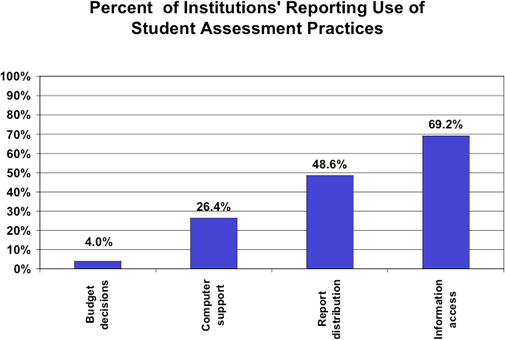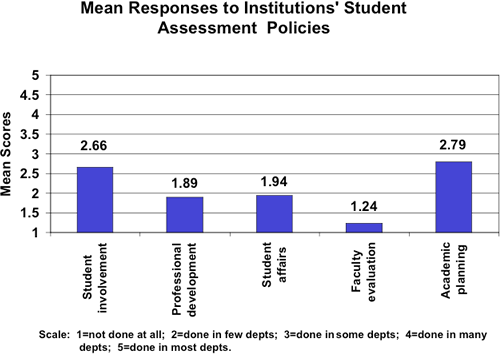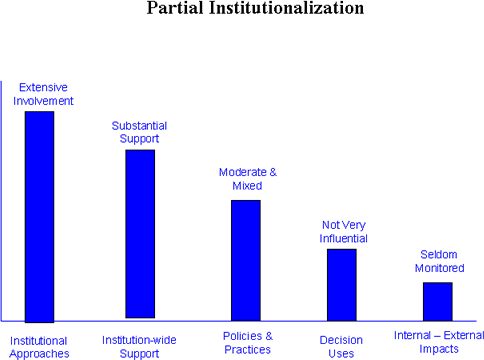Organizational and Administrative Approaches to, Support for and Uses of Student Assessment: Partial Institutionalization
The NCPI Project 5.2 national study, which included an extensive review
of the student assessment literature, a national survey, and seven institutional
case studies revealed what we have termed a pattern of partial institutionalization.
Based primarily on the national survey data and case study information,
the findings point to a process of student assessment that has yet to
be fully developed and incorporated into the organizational and administrative
processes of institutions. While most institutions have responded to the
general trend toward increased student assessment either by choice, state
mandate, and/or accreditation requirements (see Peterson & Augustine,
2000), the level of effort has varied greatly from institution to institution
and has generally decreased in use as we track the student assessment
process through the domains of our conceptual framework (see Peterson
& Einarson, 2001).
Institutions are putting forth the most effort in the domain of institutional
approaches to student assessment although the extent of data collection
among all institutions is limited. They are most likely to collect various
types of student assessment information (cognitive, affective, and post-college)
at various points throughout students’ careers (entry, during, exit,
and post graduation), but they seldom collect the same data at two points
in time (value added). They also use a variety of instruments and methods
of collecting the student assessment information. Additionally, the institution-wide
strategies, support mechanisms, and leadership patterns for student assessment
were widely used among the institutions studied. Institutional planning
for student assessment, providing committees or offices providing direction
and guidance, and establishing formal policies and planning groups were
most widely adopted. However, the actual assessment management policies
and practices that were implemented to support and promote student assessment
on an on-going basis lacked the complete focus and commitment throughout
the institution and institutional efforts in this area appeared to take
on a “hit or miss” characteristic. Additionally, we found that
the integration of student assessment into areas academic management and
educational improvement fell well below our expectation. Institutional
uses of student assessment information for academic decision-making and
educational improvement in a manner consistent with a fully institutionalized
student assessment process were disappointingly low. Finally, virtually
no institutions track the impacts of the student assessment information
on the institution despite proponents’ assurances of its many benefits.
Thus, we conclude that most institutions have only a partially institutionalized student assessment on their campuses. Some of the general findings:
External Influences of Student Assessment
Approach to Student Assessment
Institution-wide Strategy, Support, and
Leadership for Student Assessment
Assessment Management Policies and Practices
Uses and Impacts of Student Assessment Information
Conclusion
(For a more detailed examination of the various findings
see the following articles: Peterson & Augustine, 2000a; Peterson
& Augustine, 2000b; Peterson & Einarson, 2000; Peterson &
Einarson, 2001; Peterson, Vaughan, & Perorazio, 2001; Peterson &
Vaughan, 2002.)
External Influences of Student Assessment
State Influence:
- Over half (54%) of institutions reported having a state assessment plan.
- Close to half (45.1%) of institutions reported state requirements played an important role in initiating student assessment and nearly two-thirds (62.4%) indicated state requirements had increased institutional involvement in student assessment.
Accreditation Influence:
- Four-fifths (80.3%) of institutions reported having completed a regional accreditation review.
- Nearly two-thirds (63.6%) of institutions reported regional accreditation requirements as an important reason for initiating student assessment and nearly four-fifths reported regional accreditation requirements as a reason for increased institutional involvement in student assessment.
- Most institutions (79%) had not received external sources of support for improving student assessment.
Approach to Student Assessment
Extensiveness of Student Assessment:
- A substantial number of institutions collected data for many or all students on at least two measures of student outcome.
- Though nearly ninety percent of institutions used up to seven different student outcome measures, few measures were used for all students.
- Of the various types of student assessment data collected, institutions collected post-college assessment data more extensively than data concerning current students’ cognitive performance or affective development.


Methods of Student Assessment:
- Fewer than 30% of institutions used student-centered methods (portfolios, capstone projects, etc.) in most or all units.
- Use of external assessment methods (employers or alumni) was comparatively greater than other methods.
- Among institutions using student assessment measures, institutionally developed instruments were the most dominant mode.
- Institutions reported conducting few studies of the relationship between aspects of students’ institutional experience and student performance.
- Institutions produced and provided reports of student assessment results at several levels of aggregation.



Institution-wide Strategy, Support, and Leadership for Student Assessment
- Institutions reported a moderate degree of mission emphasis on undergraduate education but little emphasis of the importance of student assessment.
- Preparing for accreditation self-study was reported as the most important purpose for engaging in student assessment followed by meeting state requirements and internal improvement.
- Creating a faculty governance committee and providing student assessment workshops for administrators emerged as the two most common administrative and governance activities to promote student assessment.
- Academic affairs administrators were reported as the most supportive of student assessment and faculty governance as the least supportive of administrative and faculty support groups.
- Half of all institutions have a student assessment plan or policy requiring specific student assessment activities of all academic units.
- More than two-thirds of institutions have an institution-wide planning group for student assessment.




Assessment Management Policies and Practices
Practices:
- Nearly three-fourths (69.2%) of institutions reported providing access to student assessment information.
- Almost half (48.6%) of institutions distributed student assessment reports at various levels of the institution.
- Only one in four (26.4%) provided computer information systems support for student assessment.
- Few institutions (4.0%) used student assessment information in the budget process.

Policies:
- Institutions were most likely to use student assessment performance data in academic planning and review processes.
- Institutions were likely to have policies encouraging student involvement in assessment activities.
- Few institutions had policies for encouraging professional development in the area of student assessment.
- Few institutions involved the student affairs staff in the student assessment process.
- Institutions rarely if ever linked faculty evaluation and reward policies to student assessment involvement or results.

Uses and Impacts of Student Assessment Information
Uses:
- Student assessment information has had limited influence on institutions’ educational decision-making and even less on faculty-related decisions.

Impacts:
- Most institutions reported that they had not monitored assessment related impacts.
Conclusion
The results show that institutions’ student assessment effort
has only been partially institutionalized. Based on the findings from
each of the domains, institutions are extensively involved in institutional
approaches to student assessment. Most provide substantial institution-wide
support and leadership, but only moderate or mixed levels of policies
and practices for student assessment. The use of student assessment information
is limited and not very influential and institutions seldom, if at all,
monitor the impacts from student assessment efforts.

